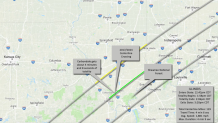Chicagoans could catch an extraordinary sight this month as a total lunar eclipse will be visible in the Midwest in on May 15.
According to the Adler Planetarium, a Flower Moon will pass into Earth's shadow at 8:32 p.m. to create a total lunar eclipse.
"A total lunar eclipse occurs when the Moon is fully engulfed by the Earth’s shadow," the Adler Planetarium wrote online. "Once totality begins, the Moon can appear reddish due to our atmosphere scattering away the bluer rays of the Sun’s light, just like the Sun appears reddish right before sunset."
May's Flower Moon is also called the Blood Moon by some due to the red color it gives off. However, that isn't unique to this year as the moon typically appears red during a lunar eclipse, the planetarium wrote.
Feeling out of the loop? We'll catch you up on the Chicago news you need to know. Sign up for the weekly Chicago Catch-Up newsletter here.
This interactive map shows which stage of the eclipse will be visible from your location.
As of Tuesday, timeanddate predicted the weather on May 15 will be mostly sunny and cool, though forecasts could change over the next two weeks.
The planetarium noted that the eclipse will begin at 8:32 p.m., then move into a partial eclipse at 9:27 p.m. Totality is set to start at 10:29 p.m. and end at 11:53 p.m. The partial lunar eclipse will then end 12:55 a.m. on May 16.
Local
In about two years, a total solar eclipse will also be visible from Illinois.
On April 8, 2024, the event will be the last visible total solar eclipse from the U.S. until 2045.
More 31 million people across 13 states — including Illinois — live in "the path of totality" for the event — meaning those places will see 100% totality.
According to the website nationaleclipse.com, in Illinois, the state of totality will begin on April 8, 2024 at 1:58 p.m. and end at 2:06 p.m.

In southern Illinois near Carbondale, the eclipse will be in the path of totality, meaning a total solar eclipse will be visible. The eclipse path map on timeanddate.com shows that in Chicago, the solar eclipse will only partially visible in Chicago, at 93.9%.
Check to see what the visibility will be in your city, here.
According to the Adler Planetarium, a solar eclipse can only occur at the New Moon Phase, when the arrangement in space is a line between the Sun, Moon, and Earth.
The moon, directly between the sun and Earth, casts a shadow on the planet, darkening the daytime sky. Those in the dark part of the moon’s shadow, the umbra, will experience a total eclipse, while those in the light part, the penumbra, will see a partial eclipse.
The period of totality refers to the time during a total eclipse when the moon completely obscures the sun. The period of totality is usually brief, lasting just a few minutes. Astronomy.com says the maximum period of totality for the April 8, 2024, solar eclipse is four minutes and 28 seconds.
The longest period of totality for the 2017 solar eclipse was quite a bit shorter, just about two minutes and 40 seconds, according to NASA.



